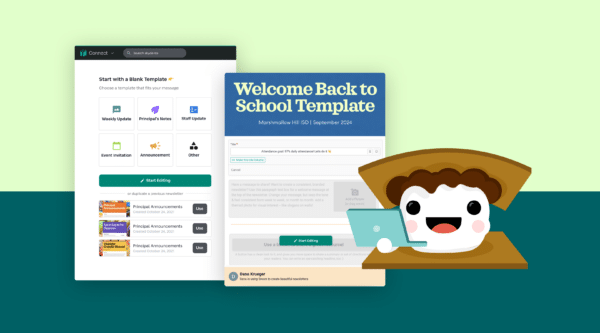

The English Learner/Emergent Bilingual population is the fastest growing demographic in our schools. Recent research indicates just how important enabling families of EL students is—not just the students themselves—when it comes to academic achievement, language development, and successful integration with school environments and communities.
The question is, how do you take a holistic approach to EL families and ensure positive student outcomes? Read on to find out!
1. Create a Dedicated EL Family Support Function in Your School
Whether it’s writing EL family support goals into your school’s operating plan and dispersing responsibilities across a number of existing roles, or creating specific EL family support positions, empowering staff to dedicate more time towards assisting EL families is critical.
Not only can this enable EL students to be fully included in school activities, by ensuring EL families are well-informed about all the opportunities available to their children, you also establish deeper family-teacher relationships.
In addition to helping EL families reduce the week-to-week administrative tasks demanded of parents and caregivers, dedicated EL family support functions also embolden EL families to proactively start conversations with the school. Simultaneously, this can provide additional motivation to improve their own English skills so that they can build upon those relationships.
Regardless of the presence or absence of dedicated EL support roles in your school, a “whole school” framework and action plan for EL development and inclusion is recommended. This approach helps to ensure the concept of EL support permeates the routine operations of the school and remains top-of-mind for all staff members. Engaging your existing multilingual educators to determine how best to deliver assistance is important too.
Additionally, wherever possible, EL support staff should remain in positions of responsibility over a reasonable period—no less than 12–24 months. This will help build trust and strong, lasting relationships between EL families and teachers.
Further reading: Engaging ELL Families: 20 Strategies for School Leaders
2. Build EL Partnerships with Other Cultural or Linguistic Entities
Engaging with other organizations and community groups that specialize in foreign languages and cultures, both in terms of transferring knowledge and assisting with integration, can be hugely beneficial. And, the benefits flow two ways—EL families feel welcomed and visible, and they can see that they have a voice within the school community. At the same time, non-EL families can gain a greater appreciation for, and understanding of, other cultures within the school community.
Delivering on these desired outcomes might include engaging third-party organizations to perform at, or help run, special cultural experience days or activities for certain groups of pupils—even the broader school community. Seeking input and assistance from EL families with relevant cultural backgrounds can bear additional fruit.
To further grow the confidence and active participation of EL families, consider partnering with third-party adult and child EL specialty organizations to deliver after-hours English classes. To make such programs even more logistically and economically accessible, consider subsidizing costs or using school facilities to host classes.
Improving families’ language skills can aid social integration, inside and outside the school community, and lead to more effective support for EL students as families are able to effectively articulate goals, concerns, and needs.
Further reading: Education USA: English Language Programs
3. Establish an ELL Onboarding Program
New EL families have often traveled significant distances for economic, social, or political reasons. Therefore, many may be completely unfamiliar with your system of schooling.
Establishing a structured onboarding program can help EL families understand basic school requirements, and where and how they can seek resources or assistance, which in turn will help EL students settle into school and achieve better academic results. The quicker these family-school relationships can be established, the more likely EL families are to remain at and prosper in your school.
Elements of the onboarding program may include, but are certainly not limited to, the following:
- Admission templates and assistance in native languages
- Assessment of new EL students to help formulate a customized learning and support package for families and teachers to enact
- Resources to ease the transition—ranging from overview materials on your district’s education system to information about local public transport options
- Methods to ease the transition—including in-home discussion and learning strategies to help EL families facilitate student academic achievement and ease social tensions
- Curriculum outlines and student learning objectives in home languages
- Local and online English language resources for both students and adults
Further reading: ESL Resources for Students, Parents and Teachers
4. Hold Regular ELL Community Sessions
While formalized EL onboarding programs are a great place to start, running regular meet-ups can cement content and concepts shared during registration and onboarding, provide an open forum for questions, and build stronger relationships with EL families and teachers, as well as between EL families.
School churn rates among EL families are often high due to the number of challenges they face. Consistently providing newly-arrived EL families with access to tools, resources, and people to help navigate those challenges can help significantly reduce those churn rates.
EL get-togethers at your school provide a regular forum and framework through which you can:
- Communicate and reiterate school expectations around common themes like student attendance and participation, family engagement, and homework—many of which may be new concepts that need reinforcing to some EL families
- Share resources and communicate information about your school’s teaching program
- Encourage family learning by providing or recommending English Language Learning programs for families
- Create an immediate feedback loop, whereby families can have direct input into the ongoing development of EL enablement strategies
- Facilitate and nurture EL community-building amongst families (social isolation is common among migrant families, and overcoming this hurdle helps provide a stable environment for ongoing student learning in the home)
Also consider holding sessions outside the school grounds, in more neutral venues, where EL families may be less intimidated by the enormity of a foreign school system, and therefore may also be more open to actively participating.
Getting to know EL families also builds important school-related relationships based on trust, which in turn can pave the way to student success. This approach is most effective when the communication is personal and face-to-face.
4.1 Establish EL Student Support Groups
Organizing support groups for EL students who share common language backgrounds assists ongoing learning and relationship development. Additionally, they also act as a backdoor avenue for EL families to:
- Learn additional techniques for ongoing English language development at home
- Meet fellow EL families
Further reading: The Power of Family School Community Partnerships
5. Encourage EL Families to Participate in School Events
Schools are always looking for additional family volunteers to support a range of activities— from music programs and theater productions to sports carnivals and school trips.
These events are fantastic for bridging the divide between EL and non-EL families. Increasing dialogue between the families of EL and non-EL students is also demonstrated to improve the engagement rates of EL families while simultaneously enhancing relationships between EL and non-EL students.
Encouraging EL families to volunteer in day-to-day school life can also elicit similar benefits—from the classroom to the office, library, lunchroom, school clubs, sports teams, and after-school programs.
5a. Inclusion in Volunteer Reading Programs
A school-based study identified the most important elements of creating “school-literate ELL families.” At the time, 98 percent of enrolled students were from diverse backgrounds with 45 different languages spoken at home. The study, Becoming School Literate Parents: An ESL Perspective, found “access to school literacy practices” was “fundamental to parental involvement in literacy learning.”
The report identified a number of practical activities that promote literacy learning and offer usable strategies to “extend the learning” of EL children, including EL family participation in:
- School meetings
- Close interactions with class teachers and, most importantly
- Participation in volunteer reading programs and observations of the classroom teacher in action
This style of direct observation and participation by EL families also increases family-student collaboration on out-of-classroom school work.
5b. Student Participation in Extracurricular Activities
ELL student participation in extracurricular activities is important for developing confidence and facilitating inclusion. It also offers an additional avenue through which ELL families can form new relationships and integrate comfortably with the school community.
Further reading: Engaging the families of English learners in classrooms, schools and communities
6. Provide Professional EL Learning and Development for Staff
To develop a truly holistic approach to supporting EL families, and embracing the multilingual nature of your school, it’s important that you provide all teachers and support staff with opportunities to learn EL techniques. These techniques can then be incorporated into general teaching practices.
For example, this might include developing a better understanding of direct teaching tactics that are engaging and enable strong participation from students who are not yet proficient in English. These techniques and concepts may include:
- Narrative and visual-based resources and learning approaches
- Technology-driven aids that support EL learning and participation
- Immersion tactics that don’t require sophisticated English skills, helping EL students to integrate socially and experience the full curriculum
Aside from specific tactics and techniques for the successful implementation of EL-conscious teaching practices, EL-centric professional learning and development opportunities should aim to equip staff with:
- A thorough understanding of the additional resources and areas of assistance English learners require to achieve success—in any area of study
- The ability to identify and incorporate language learning strategies when teaching content—in any area of study
- Resources and strategies to help plan different lessons for English learners—in any area of study
- Effective evaluation and assessment frameworks for measuring EL student progress, divergent from English language capabilities
Lastly, simply supplying sufficient information to staff about your EL cohort’s countries of origin will also assist social and academic integration—for families, students, and staff alike.
Further reading: What Teachers Should Know About Instruction for English Language Learners
7. Encourage Bilingual Conversation at Home
Oftentimes, both EL families and teachers want to totally immerse students in the English language, and are therefore hesitant to encourage native language usage. However, research indicates shunning native language conversation and learning at home can have a detrimental impact on English language development.
In fact, families should be supported to continue native language learning at home, as research demonstrates that EL students with strong native language skills pick up English faster and achieve superior academic results generally. Schools can support this endeavor by providing further learning resources and reading materials in common additional languages.
While generally important, this concept is particularly critical for younger students learning the fundamentals of language construction and reading for the first time. If EL students do not become proficient in their first language before attempting to learn English, their efforts are severely hampered because they have not previously learned the structures, techniques, patterns, and processes, which they can refer back to when studying English.
Additionally, restricting at-home interactions and learning to English can also restrict an ELL family’s ability to help their children due to their own English limitations.
Further reading: Raising a Truly Bilingual Child
8. Encourage Multilingual Practices Within the Classroom, too
Embracing the multilingual nature of the modern student body, outside of the traditional confines of Language Other Than English (LOTE) classes, can contribute to developing the “whole school” multi-language strategy discussed in point one.
The first step for introducing multilingual teaching strategies across multiple subjects and grades is to develop a district – or school-level policy, which gives educators guidelines for effective implementation. This policy should be created in consultation with key stakeholders—teachers, EL families and students, as well as non-EL families and students.
Part of this policy should also include clear guidelines for assessing the development of EL students, which weight achievement differently, in order to prevent inadvertently discouraging EL families and students from continued academic achievement, English language improvement, and social integration efforts.
Such transparency and active integration can also help combat the development of false assumptions and generalized misconceptions regarding EL families amongst non-EL students and families.
Additionally, multi-language engagement models can help reduce the need to undesirably cluster EL students in common class groupings—based purely on English comprehension levels—to the detriment of ongoing integration efforts.
Further reading: Enhancing learning of children from diverse language backgrounds; Embracing Language Diversity in Your Classroom
9. Form strong relationships between EL families and school counselors
For high schools in particular, it’s important that to ensure EL families and counselors form strong partnerships.
Many are less likely to know all the options available to their children: study requirements, the ins and outs of the local education system, or labor markets. Empowering them to actively partake in their children’s study and career choices is vital.
Here are some of the key considerations counselors should be supported to take into account when discussing post-high school pathways with EL families and their children:
- EL families, and therefore parental expectations, vary widely. The families of international students may have vastly different levels of education attainment, understanding, and post-school study or work expectations compared to refugee or migrant families
- Different cultures:
- Place different values on different types of education and career choices—be aware of these nuances to avoid awkward conversations
- Have diverse family decision-making processes—understand where they are in order to include and balance family and child input as appropriate
- Put varied amounts of pressure on their kids to achieve in school—know when you need to encourage families to take a step back or become more involved in order to help their student succeed
- Explore the EL families’ own experiences and understanding of the labor market, putting that knowledge in context by contrasting it with employment patterns and opportunities in the local labor market
- Explain different types of educational pathways and qualifications, the opportunities with which they align, and the requirements that need to be considered
- Have the resources required to support EL families to access and apply for post-secondary education opportunities
- Provide multilingual support by providing access to interpretation services and translations of career advice publications where feasible
Further reading: English Language Learners and Increasing College-Going Culture: Suggestions for School Counsellors
10. Establish a reliable two-way multilingual communication process
While encouraging EL families to improve their English skills is important, sometimes there’s no room for error when communicating critical information.
Embracing smart technology that allows EL families to receive and respond to school permission, consent and information requests (such as student medical conditions) in their native language can be a true game-changer.
Such technology-enabled automation not only makes two-way multi-language communication possible, but ensures accuracy of data, safety, and full inclusion of EL students in school events and activities—while keeping all families equally well-informed.
Teacher and bilingual learning expert, Farin A Houk, states the importance of “establishing two-way communication on both sides,” as well as the need for a translation process that is “formal, steady, and reliable.” Houk emphasizes that non-formalized and non-process-driven methods—such as “talking slower or louder, simplified words and gestures, or using students or family for confidential or in-depth translation/interpreting”—are unsatisfactory, unreliable, and place EL families at a comparative disadvantage.
In addition, automated and digitized distribution of translated and/or multi-language communications also enables schools to survey EL families in their home language, empowering them to continually improve inclusivity with direct input into EL programs and support services.
But, make sure you’re ready to take that feedback seriously and act on it—otherwise, you run the risk of permanently alienating new EL families. Houk notes that EL families, “should not be ‘included’ to rubber stamp school decisions, or to provide affirmation for school staff about decisions made with no real input.”
Further reading: An exploration of school communication approaches for newly arrived EAL students: applying three dimensions of organizational communication theory
How SchoolStatus Can Help
Removing the pain of paperwork—in 130+ languages
Effectively communicate with families, staff, and your whole school community with smart, automated workflows in any language.
Create, distribute, and collect responses to digital forms, permission slips, incident reports, approval requests, and more in 130+ languages with SchoolStatus Forms & Flows. Eliminate your expensive, inefficient paper-based processes, and empower your English Learner families like never before.
Stay Connected
News, articles, and tips for meeting your district’s goals—delivered to your inbox.





